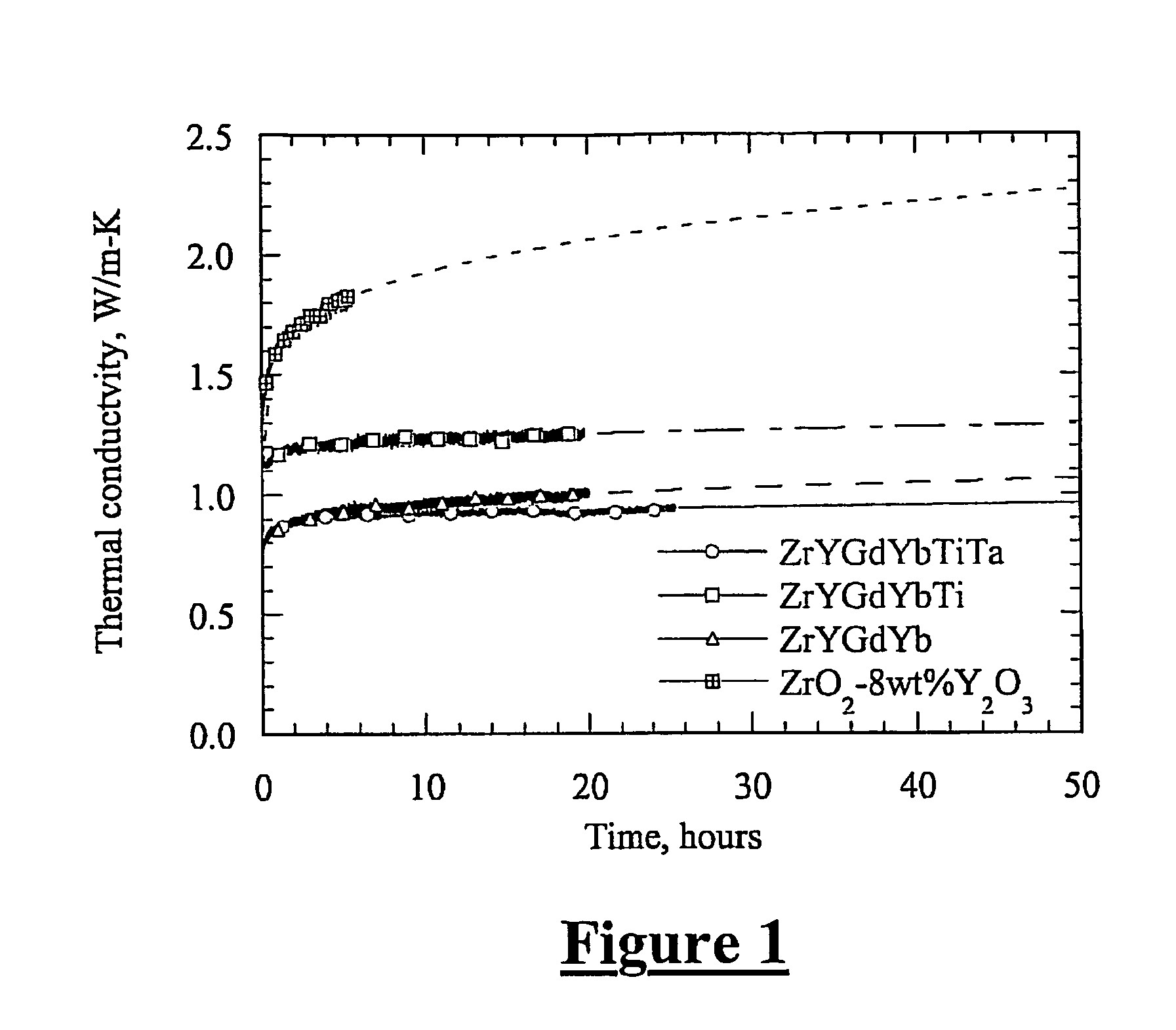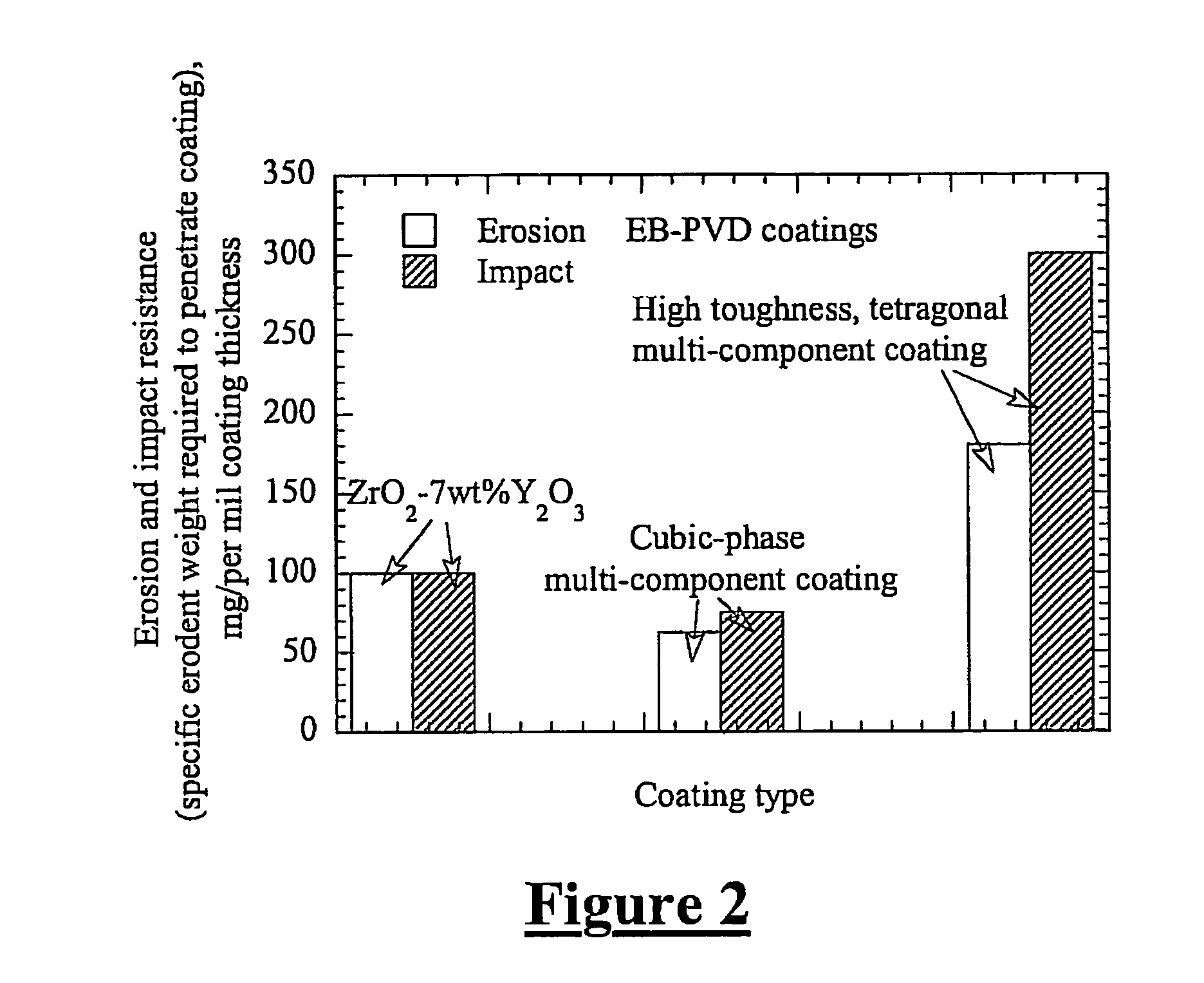Low conductivity and high toughness tetragonal phase structured ceramic thermal barrier coatings
a ceramic thermal barrier and low conductivity technology, applied in the direction of vacuum evaporation coating, metallic material coating process, climate sustainability, etc., can solve the problems of limited temperature capability of coatings, current zirconia, engine performance and efficiency severely limited, etc., to improve toughness and thermal conductivity
- Summary
- Abstract
- Description
- Claims
- Application Information
AI Technical Summary
Benefits of technology
Problems solved by technology
Method used
Image
Examples
example 1
[0021]Titania and tantala were incorporated within a four-component coating system with a composition of (mol %):
ZrO2-2.4Y2O3-1.8Gd2O3-1.8Yb2O3-5TiO2-5Ta2O5
[0022]FIG. 1 demonstrates the low conductivity of the present invention for plasma-sprayed coatings exposed to steady-state, simulated thermal gradient testing at a surface temperature of between 1500 to 1550° C. The six-component ZrO2-2.4Y2O3-1.8Gd2O3-1.8Yb2O3-5TiO2-5Ta2O5 coating (shown as ZrYGdYbTiTa in the figure) exhibited low conductivity and high thermal stability compared to a current state-of-the-art ZrO2-8 wt % Y2O3 baseline coating, a four-component (mol %) ZrO2-2.4Y2O3-1.8Gd2O3-1.8Yb2O3 coating (shown as ZrYGdYb in the figure) and a five-component (mol %) ZrO2-4Y2O3-3Gd2O3-3Yb2O3-5TiO2 coating (shown as ZrYGdYbTi in the figure). In fact, the composition of the present invention provides a one-half to one-third reduction in thermal conductivity compared to the baseline ZrO2-8 wt % Y2O3 coating.
example 2
[0023]Titania and tantala were incorporated within a four-component coating system illustrated by:
ZrO2(HfO2)—Y2O3—RE2O3(A)-RE2O3(B)—TiO2Ta2O5
[0024]in the concentration range of 0.5 to 10 mole percent. FIG. 2 demonstrates the improved erosion and impact resistance of the present invention for electron beam physical vapor deposited coatings exposed to an erodent of alumina (Al2O3) required to penetrate a unit thickness of the coating. The high toughness tetragonal multi-component coating exhibited significant improvement in erosion and impact resistance compared to a baseline ZrO2-7 wt % Y2O3 coating and a cubic-phase multi-component coating. In fact, the composition of the present invention provides a factor of two improvement in erosion and impact resistance compared to the baseline ZrO2-7 wt % Y2O3 coating.
example 3
[0025]Titania and tantala were incorporated within a four-component coating system with a composition of (mol %):
ZrO2-4Y2O3-3Gd2O3-3Yb2O3-5TiO2-5Ta2O5
[0026]FIG. 3 demonstrates the improved erosion resistance of the present invention for electron beam physical vapor deposited coatings (shown as ZrYGdYbTiTa in the figure) exposed to an erodent of alumina (Al2O3) at 1204° C. compared to a four-component (mol %) ZrO2-4Y2O3-3Gd2O3-3Yb2O3 coating (shown as ZrYGdYb in the figure) and a baseline ZrO2-7 wt % Y2O3 coating. In addition, FIG. 4 illustrates the improved cyclic oxidation resistance of the ZrO2-4Y2O3-3Gd2O3-3Yb2O3-5TiO2-5Ta2O5 coating (shown as Zr4Y3Gd3Yb5Ti5Ta in the figure) compared to a baseline ZrO2-7 wt % Y2O3 coating.
[0027]The addition of titania and tantala also enhances the oxide atomic bonding of the coating system, thereby resulting in a high chemical stability and intrinsic strength of the oxides. Therefore, the thermal shock resistance and long term durability of the ...
PUM
| Property | Measurement | Unit |
|---|---|---|
| Power | aaaaa | aaaaa |
| Size | aaaaa | aaaaa |
| Lattice constant | aaaaa | aaaaa |
Abstract
Description
Claims
Application Information
 Login to View More
Login to View More - R&D
- Intellectual Property
- Life Sciences
- Materials
- Tech Scout
- Unparalleled Data Quality
- Higher Quality Content
- 60% Fewer Hallucinations
Browse by: Latest US Patents, China's latest patents, Technical Efficacy Thesaurus, Application Domain, Technology Topic, Popular Technical Reports.
© 2025 PatSnap. All rights reserved.Legal|Privacy policy|Modern Slavery Act Transparency Statement|Sitemap|About US| Contact US: help@patsnap.com



